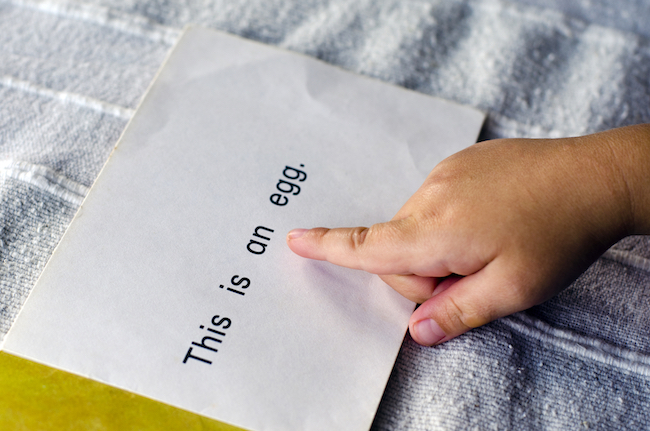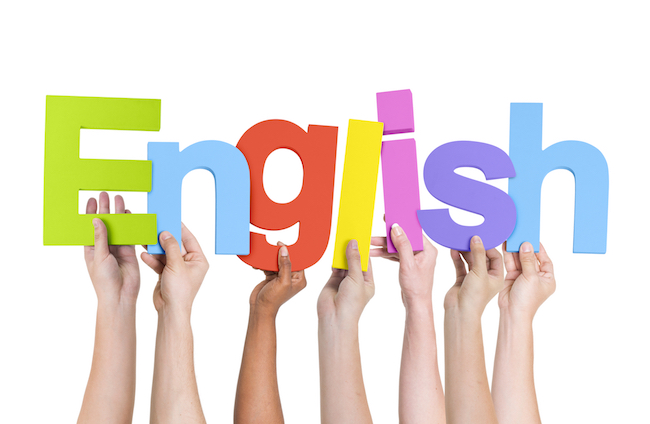Haven’t heard of the Dolch list? Don’t worry. If you’ve ever read Dr. Seuss you know a good portion of it already. In fact, every word in The Cat in the Hat is on the Dolch list.
Dolch words are high frequency English vocabulary commonly used to teach children to read. Learning to recognize them automatically can facilitate fluency in reading.
Think of the most common English articles, prepositions, conjunctions, adjectives, adverbs and verbs (a, and, away, big, blue, can, come, down) and you’ll get a good idea of the list.
Who can benefit from Dolch words?
Dolch words, also known as sight words, account for between 50-75% of all vocabulary found in grade school reading material.
However, it isn’t just grade school children who can benefit from learning the Dolch word list.
Individuals with dyslexia and other learning difficulties may find memorizing the list a useful activity because it facilitates the development of reading and spelling skills.
Adults who are struggling readers can also benefit from learning Dolch words. Those students who are learning English as a second or additional language may be tasked with mastering Dolch words in beginner level classes.
Who wrote the Dolch word list?
The Dolch word list was created by Edward William Dolch in 1936 and first published in Problems in Reading in 1948. Dolch worked at the University of Illinois and based the list on the most common words in children’s books at the time.
This was a genre he was familiar with given he wrote and published many collections of stories, including interpretations of Aesop’s fables and even a title today’s Internet would fall head over heels for, I like cats: True cat stories.
Dolch recognized the value in teaching first-grade readers high frequency words without forcing children to memorize a list of 500+ terms.
He narrowed his collection to 220 words and chose to leave nouns off of the list. The reason behind this decision was that nouns tend to be related to specific content and the more generic “service” words could be found across many different kinds of books and reading materials, regardless of topic.
Dolch later released a list of 95 Dolch list nouns, which can be used in beginning reading instruction as sight words that most facilitate comprehension.
Learn more about teaching children to read and 6 important pre-literacy skills.
Basic sight words in reading
Children who are learning to read at a first-grade level must first decode words on a page. This involves mapping phonemes to graphemes, also known as sounding out words—a challenging activity in English given the irregularity of the language’s spelling.
Dolch recommended that his list be memorized so children could immediately recognize the words they most frequently encounter without having to sound them out.
This recognition process mimics the way we read language as adults.
Have you ever been asked to read a paragraph where all of the words are spelled incorrectly? As long as the first and last letters of the word remain intact, the internal letters can be scrambled into any order and it is still possible to read the paragraph normally.
This is because adults do not sound out words, rather they sight read.
Adult reading is about recognizing the collection of letters that make up a word and then scanning the mental lexicon for the best meaning candidate, based on the context in which the word appears and the topic of the text.
Teaching Dolch sight words
While teaching reading to children starts with the decoding process, as children begin to recognize more words, they gradually transition to sight reading. Sight reading speeds up reading and frees up cognitive resources so they can be used to process less frequent vocabulary and enhance comprehension.
TOP TIP: Did you know both in first and second language reading, individuals need to be able to recognize 90% of the words in a sentence in order to make good guesses and acquire new vocabulary from context? (1)
Learn more tips and strategies for teaching sight words.
Dyslexia and sight words
In addition to children and beginner readers, the Dolch word list is particularly helpful for individuals with dyslexia and other learning difficulties.
For people without dyslexia, vocabulary size and literacy skills go hand in hand: reading is the most effective way to build breadth and depth in vocabulary and having a larger vocabulary greatly enhances reading comprehension skills.
Yet dyslexia affects the initial stages of language decoding and can cause learners to struggle with activities involving reading and spelling. Sight reading helps dyslexic students skip the decoding process.
Why Dolch words are hard for children with dyslexia to learn
Individuals with dyslexia may struggle to read even the most frequently encountered words. As Dolch words are often abstract service words, they can be harder for dyslexics to learn to spell compared to concrete nouns, which may be more easily linked to an image or mnemonic device.
When short term memory is an issue, a strategy for learning Dolch words might involve repetition and multi-sensory teaching.
Touch-type Read and Spell
The TTRS course is a multi-sensory typing program that teaches keyboarding and reinforces literacy skills at the same time. One of the main goals of the course is to enhance frequency of exposure to sight words. They are included in early modules and featured in a specific Dolch words subject.
A learner sees the words on screen, hears them read aloud, and types them. This creates a more lasting and dynamic memory and helps with learning.
Learn more
While TTRS was originally designed to help dyslexic learners acquire typing skills, it can be used to help any child or adult with literacy and typing.
Adult learners and EAL pupils
Learning high frequency words, including Dolch sight words, facilitates reading and listening comprehension skills in adult, EAL and EFL education.
Time is power in reading, and familiarity with sight words allows adults with poor reading skills, as well as English as a second language learners, to read more quickly and focus on the less frequent vocabulary in texts.
Have you studied or taught the Dolch sight words? Please share your experience with us!
References:
(1) Nation, I.S.P. (1997), Vocabulary size, text coverage, and word lists, in Schmitt; McCarthy, Vocabulary: Description, Acquisition and Pedagogy, Cambridge: Cambridge University Press, pp. 6–19.
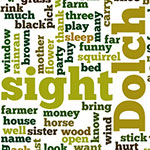
Dolch Word Lists
All the Dolch sight word lists, divided by grade, also available as printable PDFs.
More

Dolch Sight Word Lessons
Five techniques for teaching Dolch sight words. Learn proven ways to introduce words, reinforce learning, and correct mistakes.
More
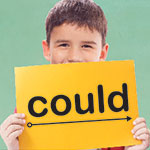
Dolch Flash Cards
Print a set of Dolch sight word flash cards, or use our generator to create your own custom cards.
More
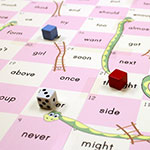
Dolch Sight Word Games
Print cards and game boards for 18 Dolch sight word games. A fun way to reinforce sight words lessons!
More
The Dolch Sight Words list is the most commonly used set of sight words. Educator Dr. Edward William Dolch developed the list in the 1930s-40s by studying the most frequently occurring words in children’s books of that era. The list contains 220 “service words” plus 95 high-frequency nouns. These words comprise 80% of the words you would find in a typical children’s book and 50% of the words found in writing for adults. Once a child knows this list of words, it makes reading much easier, because the child can then focus his or her attention on the remaining words.
The Dolch words are commonly divided into groups by grade level, ranging from pre-kindergarten to third grade, with a separate list of nouns. There are a total of 315 Dolch Sight Words.
Dolch Word Lists
- Pre-K Dolch Sight Words
(40 words)a, and, away, big, blue, can, come, down, find, for, funny, go, help, here, I, in, is, it, jump, little, look, make, me, my, not, one, play, red, run, said, see, the, three, to, two, up, we, where, yellow, you
- Kindergarten Dolch Sight Words
(52 words)all, am, are, at, ate, be, black, brown, but, came, did, do, eat, four, get, good, have, he, into, like, must, new, no, now, on, our, out, please, pretty, ran, ride, saw, say, she, so, soon, that, there, they, this, too, under, want, was, well, went, what, white, who, will, with, yes
- First Grade Dolch Sight Words
(41 words)after, again, an, any, as, ask, by, could, every, fly, from, give, going, had, has, her, him, his, how, just, know, let, live, may, of, old, once, open, over, put, round, some, stop, take, thank, them, then, think, walk, were, when
- Second Grade Dolch Sight Words
(46 words)always, around, because, been, before, best, both, buy, call, cold, does, don’t, fast, first, five, found, gave, goes, green, its, made, many, off, or, pull, read, right, sing, sit, sleep, tell, their, these, those, upon, us, use, very, wash, which, why, wish, work, would, write, your
- Third Grade Dolch Sight Words
(41 words)about, better, bring, carry, clean, cut, done, draw, drink, eight, fall, far, full, got, grow, hold, hot, hurt, if, keep, kind, laugh, light, long, much, myself, never, only, own, pick, seven, shall, show, six, small, start, ten, today, together, try, warm
- Noun Dolch Sight Words
(95 words)apple, baby, back, ball, bear, bed, bell, bird, birthday, boat, box, boy, bread, brother, cake, car, cat, chair, chicken, children, Christmas, coat, corn, cow, day, dog, doll, door, duck, egg, eye, farm, farmer, father, feet, fire, fish, floor, flower, game, garden, girl, goodbye, grass, ground, hand, head, hill, home, horse, house, kitty, leg, letter, man, men, milk, money, morning, mother, name, nest, night, paper, party, picture, pig, rabbit, rain, ring, robin, Santa Claus, school, seed, sheep, shoe, sister, snow, song, squirrel, stick, street, sun, table, thing, time, top, toy, tree, watch, water, way, wind, window, wood
- All Dolch Sight Words by group
- All Dolch Sight Words in alphabetical order
Leave a Reply
Recent Blog Posts

Case Wars: Upper vs. Lower Case Letters
September 27, 2016
Some of our visitors ask us why all our materials are printed in lower-case letters as opposed to upper-case letters. We know that many preschool and kindergarten teachers focus on teaching upper-case letters first. The ability to recognize lower-case letters … Continued

Is It Dyslexia?
August 29, 2016
We sometimes get questions from SightWords.com visitors who are concerned that their child or grandchild may have a learning disability. Of particular concern is the possibility that their child might have dyslexia. Many people assume that dyslexia is a visual … Continued

SightWords.com at the Southeast Homeschool Expo
August 10, 2016
On July 29th and 30th, board members of the Georgia Preschool Association met at the Cobb Galleria Centre just outside Atlanta to attend the Southeast Homeschool Expo, a convention for homeschooling families and resource providers from across the Southeastern U.S. … Continued
© 2023 Sight Words: Teach Your Child to Read
For computer manufacturer, see Dolch.
The Dolch word list is a list of frequently used English words (also known as sight words), compiled by Edward William Dolch, a major proponent of the «whole-word» method of beginning reading instruction. The list was first published in a journal article in 1936[1] and then published in his book Problems in Reading in 1948.[2]
Dolch compiled the list based on children’s books of his era, which is why nouns such as «kitty» and «Santa Claus» appear on the list instead of more current high-frequency words. The list contains 220 «service words» that Dolch thought should be easily recognized in order to achieve reading fluency in the English language. The compilation excludes nouns, which comprise a separate 95-word list. According to Dolch, between 50% and 75% of all words used in schoolbooks, library books, newspapers, and magazines are a part of the Dolch basic sight word vocabulary; however, bear in mind that he compiled this list in 1936.
Critics[edit]
Critics of teaching reading using whole word and whole language methods (and proponents of phonics) maintain that memorizing whole words may do more harm than good because it takes time away from the important aspect of practicing basic decoding techniques.[3]
Cognitive neuroscientist, Stanislas Dehaene, writes «cognitive psychology directly refutes any notion of teaching via a ‘global’ or ‘whole language’ method.» He goes on to talk about «the myth of whole-word reading» (also: sight words), saying it has been refuted by recent experiments. «We do not recognize a printed word through a holistic grasping of its contours, because our brain breaks it down into letters and graphemes.»[4] Cognitive neuroscientist, Mark Seidenberg, says «the persistence of the whole language ideas despite the mass of evidence against them is most striking at this point», and goes on to describe it as a «theoretical zombie» because it persists in spite of a lack of supporting evidence.[5] In addition, according to research, whole-word memorisation is «labor-intensive», requiring on average about 35 trials per word.[6]
Teaching strategies[edit]
These lists of words are still assigned for memorization in elementary schools in America and elsewhere. Although most of the 220 Dolch words are phonetic, children are sometimes told that they can’t be «sounded out» using common sound-to-letter phonics patterns and have to be learned by sight; hence the alternative term, «sight word». The list is divided according to the educational stage in which it was intended that children would memorize these words.
Some educators say the Dolch list can be useful if teachers do not teach children to memorize them; instead, they teach the words by using an explicit, systematic phonics approach, perhaps by using a tool such as Elkonin boxes.[7]
Some educators prefer to use the 1000 Instant Word list prepared in 1979 by Edward Fry, professor of Education and Director of the Reading Center at Rutgers University and Loyola University in Los Angeles.[8]
Dolch list: Non-nouns[edit]
Pre-primer:
(40 words) a, and, away, big, blue, can, come, down, find, for, funny, go, help, here, I, in, is, it, jump, little, look, make, me, my, not, one, play, red, run, said, see, the, three, to, two, up, we, where, yellow, you
Primer:
(52 words) all, am, are, at, ate, be, black, brown, but, came, did, do, eat, four, get, good, have, he, into, like, must, new, no, now, on, our, out, please, pretty, ran, ride, saw, say, she, so, soon, that, there, they, this, too, under, want, was, well, went, what, white, who, will, with, yes
1st Grade:
(41 words) after, again, an, any, as, ask, by, could, every, fly, from, give, going, had, has, her, him, his, how, just, know, let, live, may, of, old, once, open, over, put, round, some, stop, take, thank, them, then, think, walk, were, when
2nd Grade:
(46 words) always, around, because, been, before, best, both, buy, call, cold, does, don’t, fast, first, five, found, gave, goes, green, its, made, many, off, or, pull, read, right, sing, sit, sleep, tell, their, these, those, upon, us, use, very, wash, which, why, wish, work, would, write, your
3rd Grade:
(41 words) about, better, bring, carry, clean, cut, done, draw, drink, eight, fall, far, full, got, grow, hold, hot, hurt, if, keep, kind, laugh, light, long, much, myself, never, only, own, pick, seven, shall, show, six, small, start, ten, today, together, try, warm
Dolch list: Nouns[edit]
(95 words) apple, baby, back, ball, bear, bed, bell, bird, birthday, boat, box, boy, bread, brother, cake, car, cat, chair, chicken, children, Christmas, coat, corn, cow, day, dog, doll, door, duck, egg, eye, farm, farmer, father, feet, fire, fish, floor, flower, game, garden, girl, good-bye, grass, ground, hand, head, hill, home, horse, house, kitty, leg, letter, man, men, milk, money, morning, mother, name, nest, night, paper, party, picture, pig, rabbit, rain, ring, robin, Santa Claus, school, seed, sheep, shoe, sister, snow, song, squirrel, stick, street, sun, table, thing, time, top, toy, tree, watch, water, way, wind, window, wood
See also[edit]
- General Service List
- Learning to read
- Most common words in English
- Phonics
- Reading education
- Sight word
- Swadesh list
- Synthetic phonics
- Teaching reading
- Word wall
References[edit]
- ^ Dolch, E. W. «A Basic Sight Vocabulary.» The Elementary School Journal, vol. 36, no. 6, 1936, pp.456-460.
- ^ Dolch, Edward William. Problems in Reading. Garrard Press, 1948, pp.99-106.
- ^ Seidenberg, Mark (2017). Language at the speed of sight. New York, NY: Basic Books. p. 147. ISBN 978-1-5416-1715-5.
- ^ Stanislas Dehaene (2010-10-26). Reading in the brain. Penquin Books. ISBN 9780143118053.
- ^ Seidenberg, Mark (2017). «In normal science, a theory whose assumptions and predictions have been repeatedly contradicted by data will be discarded. That is what happened to the Smith and Goodman theories within reading science, but in education they are theoretical zombies that cannot be stopped by conventional weapons such as empirical disconfirmation, leaving them free to roam the educational landscape.» Language at the speed of light. p. 271=author=Mark Seidenberg. ISBN 9780465080656.
- ^ Murray, Bruce; McIlwain, Jane (2019). «How do beginners learn to read irregular words as sight words». Journal of Research in Reading. 42 (1): 123–136. doi:10.1111/1467-9817.12250. ISSN 0141-0423. S2CID 150055551.
- ^ «Sight words: An evidence-based literacy strategy». www.understood.org.
- ^ Edward Fry (1979). 1000 Instant Words: The Most Common Words for Teaching Reading, Writing, and Spelling. ISBN 0809208806.
External links[edit]
- Dolch flash cards by level w/ voice
- Animated Dolch Quizzes
- Learn Dolch Sight Words with Picture me Reading
- Dolch Word — Free sight word games and printables
The term «Fry words» refers to the list of 1,000 high-frequency words compiled by Dr. Edward Fry in 1957. The list was an improvement on the Dolch words list first published in 1936.
Both the Dolch and Fry word lists were developed based on the most frequently-occurring words in the English language. The Dolch list is made up of 220 words and contains no nouns unless they can be used as another part of speech. (Dolch created a separate list of 95 nouns.)
The Fry list contains 1,000 words and includes all parts of speech. According to Readsters.com, both lists were based on secondary sources, but the Fry list was updated in 1980 to add words from a more recent word frequency count.
The Fry words list is based on the «American Heritage Word Frequency Book», whose 87,000 words are ranked by the frequency in which they occur in reading material for grade 3 to 9.
Dolch sight words are based on high-frequency words that students in kindergarten through second grade typically would be reading. They are listed by age group, whereas the first 300 Fry words are listed by order of frequency. They are broken down into groups of 100 because Fry advocated focusing on a few words at a time until a student memorized the entire list.
How Can These Lists Be Used?
Both the Dolch and Fry lists are based on whole word reading. However, a study by the National Institute of Child Health and Human Development in 2000, indicates that beginning and struggling readers see stronger outcomes when they are taught to decode words using phonics.
A recommended approach is combining explicit phonics instruction with either the Dolch or Fry list of sight words. This combination helps children build fluency quickly by providing a base of words they recognize on sight along with a method for decoding unfamiliar words.
When Should Fry Words Be Taught?
In a traditional school setting, Fry words are often taught as early as kindergarten. Once children are familiar with the alphabet and letter sounds, you can begin introducing Fry words. Start with only five to ten words. Once a student masters that list, add five to 10 more, but continue to review the previously mastered words.
Generally, children are expected to master 20 sight or high-frequency words by the end of kindergarten and 100 by the end of first grade.
In a homeschool setting, let your child’s developmental readiness be your guide. Some children are curious, eager learners who are ready to start learning high-frequency words as early as three-years-old. Others may not be ready until first or second grade or even later.
For young children, you may wish to start with only a couple of words at a time, building up to the five- to ten-word range. Let your child’s progress guide you. Move at a pace which allows your student to master the words without frustration successfully.
Ideally, sight words and high-frequency words should be taught as a supplement to phonics instruction.
First 100 Fry Words
The first 100 Fry words are ideally suited for students in kindergarten and first grade. The words are listed alphabetically below, rather than in order of frequency. They can be taught in any order. For younger students, it’s recommended to start with short words that appear frequently in the text your students are reading, such as a, the, an, can, is, of, you, he, and I.
| a | about | all | an | and |
| are | as | at | be | been |
| but | by | called | can | come |
| could | day | did | do | down |
| each | find | first | for | from |
| get | go | had | has | have |
| he | her | him | his | how |
| I | if | in | into | is |
| it | like | long | look | made |
| make | many | may | more | my |
| no | not | now | number | of |
| oil | on | one | or | other |
| out | part | people | said | see |
| she | sit | so | some | than |
| that | the | their | them | then |
| there | these | they | this | time |
| to | two | up | use | was |
| water | way | we | were | what |
| when | which | who | will | with |
| words | would | write | you | your |
Second 100 Fry Words
Both the second and third 100 Fry words are recommended for students in second to third grades. Again, it is helpful to teach the words in conjunction with those that appear frequently in the texts that your students are reading.
| after | again | air | also | America |
| animal | another | answer | any | around |
| ask | away | back | because | before |
| big | boy | came | change | different |
| does | end | even | follow | form |
| found | give | good | great | hand |
| help | here | home | house | just |
| kind | know | land | large | learn |
| letter | line | little | live | man |
| me | means | men | most | mother |
| move | much | must | name | need |
| new | off | old | only | our |
| over | page | picture | place | play |
| point | put | read | right | same |
| say | sentence | set | should | show |
| small | sound | spell | still | study |
| such | take | tell | things | think |
| three | through | too | try | turn |
| us | very | want | well | when |
| where | why | work | world | years |
Third 100 Fry Words
Once the second 100 Fry words are mastered, children can move on to the third batch of 100. Again, continue teaching the words in groups of five to ten, and move on as each group is mastered.
| above | add | almost | along | always |
| began | begin | being | below | between |
| book | both | car | carry | children |
| city | close | country | cut | don’t |
| earth | eat | enough | every | example |
| eyes | face | family | far | father |
| feet | few | food | four | girl |
| got | group | grow | hard | head |
| hear | high | idea | important | Indian |
| it’s | keep | last | late | leave |
| left | let | life | light | list |
| might | mile | miss | mountains | near |
| never | next | night | often | once |
| open | on | paper | plant | real |
| river | run | saw | school | sea |
| second | seem | side | something | sometimes |
| song | soon | start | state | stop |
| story | talk | those | thought | together |
| took | tree | under | until | walk |
| watch | while | white | without | young |
Tips for Teaching Fry Words
Help your children master the Fry words quickly and easily by making learning fun and keeping them engaged. Try some of the following activities.
Concentration: Make two identical sets of cards for the words your student is learning. Mix the cards and place them face down one at a time in even rows. Two or more students can play together, taking turns flipping over two cards each turn. They must read aloud the words they turn over.
If the words match, the student gets to keep that pair and take another turn. If not, play passes to the next student. After all the matches have been made, the child with the most pairs wins.
Go Fish. Again, start with two matching sets of word cards mixed together. Deal three to five cards to each player, depending on how many are in the set. Students take turns calling out one word in their hand and asking one other player if he has the match.
If the student gets a match, he gets another turn. If not, play passes to the next player. After all the word cards have been matched, the student with the most pairs wins.
Bingo. Create bingo cards with both mastered words and new words placed randomly on the cards. As you call out words, the students should put a marker over the word if they find it on their card. The first student to achieve a bingo with five words in a row, vertically or horizontally, wins the game.
What are Dolch Words?
Reading is the most important skill a child will ever learn. It is impossible for a person to live a productive life without being able to read, i.e.; becoming literate. In most schools, children are expected to be able to read simple sentences and stories by the end of first grade. By third grade, they are expected to be able to read almost any kind of text. As well as being able to «sound out» (phonetically decode) regularly spelled words, children must also master reading basic, common sight words.
A list of English sight words, The Dolch Word List, was compiled by Edward William Dolch, PhD, in 1948. The list was originally published in his book «Problems in Reading». Dolch compiled the list based on words used in children’s reading books in the 1930s and 40s. The list contains 220 «service words» that must be quickly recognized in order to achieve reading fluency.
The Dolch Word List is also called Sight Words or The Dolch 220. It includes the most frequently used words in the English language. Sight words make up 50 to 70 percent of any general text. Therefore, teaching The Dolch Word List is a crucial goal of education in grades kindergarten through 3.
Many of the 220 Dolch words cannot be «sounded out» and have to be learned by «sight,» that is memorized. The list is divided into grade levels. It includes pronouns, adjectives, adverbs, prepositions, conjunctions, and verbs. The basic list excludes nouns, which make up a separate 95 word list.
Because fluency in reading the Dolch 220 and the 95 nouns is essential to literacy, a variety of techniques are used to teach them, including: reading Dolch literature books, using flash cards, playing games, and writing activities. Repetition and practice are very important in making recognition of sight words automatic. Once this core of basic sight words has been memorized, children read more fluently, with greater comprehension.
You can see the Dolch word lists here.

